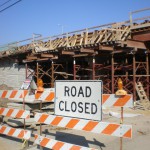The Encyclopedia of Milwaukee Documents the City
UW-Milwaukee has built a massive digital archive for the city.

View of Downtown Milwaukee from parking structure near Pabst Milwaukee Brewery & Taproom. Photo by Jack Fennimore.
An encyclopedia is the supertanker of information conveyance, its many compartments filled to the brim with its precious cargo of knowledge, ready to transport it across the seas. Like a supertanker, it is not a simple matter to load and launch an encyclopedia.
An example in point is the Encyclopedia of Milwaukee, (EMKE) a Digital Humanities Project sponsored by the History Department in the College of Letters and Science at the University of Wisconsin-Milwaukee. Work on the encyclopedia began in 2008.
A university press release on March 4th, 2020 announced that “work is complete” on the “first phase” of the encyclopedia, and goes on to say:
With nearly 700 entries ranging from Hall of Fame baseball player Hank Aaron to former Socialist Party Mayor Frank Zeidler, the online resource can be a helpful tool, especially for reporters, educators, researchers and anyone else interested in learning more about Milwaukee and its colorful past.
The entries are augmented with “hundreds of illustrations, historical and contemporary maps, bibliographic materials, and the opportunity to interact with readers.”
While the output at first seems modest for over a decade of work, it is apparent that creating a digital encyclopedia requires more than merely assembling concise essays of a thousand words or so. The team also had to build the supertanker to hold them. Any ship spends a lot of time in the boatyard before it is ready to take on cargo and set sail.
The Milwaukee Idea
As a part of the University of Wisconsin System, UWM adheres to the philosophy of the “Wisconsin Idea,” in which “university research should be applied to solve problems and improve health, quality of life, the environment, and agriculture for all citizens of the state.” Thus, an encyclopedia dedicated to the four county area (Milwaukee, Ozaukee, Washington and Waukesha — each with its own entry) would serve as an excellent interdisciplinary educational tool, with inevitable course corrections along the way.
The articles include sources, and occasional author comments on the research process, along with an opportunity for readers to comment or pursue additional research. The fact-checkers use traditional tools to verify the information, as was the case for print encyclopedias, but the electronic version requires a specialist for “curating digital primary sources to accompany entries,” a job description that would have been quite novel in 2008 academia, yet absolutely vital today.
A Search for Funding
According to Dr. Joseph B. Walzer, the project director, the launch of the encyclopedia is just the beginning:
The next stage of the project includes expanding the resources available for educators to use the encyclopedia as an interactive classroom tool to teach students. For instance, some UWM instructors and local high schools have already integrated the encyclopedia into their curriculums or used entries in projects for National History Day. … Organizers plan to make more lesson guides available for teachers. The guides are built in partnership with Milwaukee-area educators. Plans are also in the works to give students opportunities to produce digital public history pieces.
A “Staff Spotlight” in the encyclopedia provides a glimpse into the behind-the-scene workings of the project. This year he will “officially ‘launch’ the project with a series of programs and workshops, submit an application for a major grant from the National Endowment for the Humanities, and begin developing two new features that will help make EMKE a more effective teaching and learning tool (more on that at another time). Such an array of milestones requires a ton of creative planning, coordination, outreach, and know-how—precisely what Joe is here for.” Walzer has also written 34 entries for the encyclopedia.
He says, “Milwaukee is under-appreciated for its centrality to the development of national trends and movements—both good and bad,” adding “We envision this project as an ongoing dialogue with Milwaukeeans and their communities, and want people to engage EMKE as a dynamic resource. Please register and comment on the website! That will help us connect what we do with what Milwaukeeans need.”
And a little message for the thousands of reporters and delegates en route to Milwaukee this summer:
The encyclopedia can be a valuable tool for reporters seeking background and context for stories about Milwaukee and the region ahead of the Democratic National Convention.
The project also received a note of support from historian John Gurda, a UWM alumnus who serves on the encyclopedia’s advisory board:
“It’s the first digital resource of its kind in Milwaukee, and the articles are the product of sound, extensively reviewed research. In a Wiki-world, EMKE stands out boldly for its fairness, accuracy and breadth.”
That’s The Milwaukee Idea!
Support the Project
The UWM budget is perennially underfunded, as Chancellor Mark Mone will certainly agree, and humanities projects such as this are increasingly imperiled in this STEM-focused era. Major support for the project includes foundation-based funding by:
- National Endowment for the Humanities
- Greater Milwaukee Foundation
- Richard and Ethel Herzfeld Foundation
- Dorothy Inbusch Foundation
- Brookbank Foundation
Also, dozens of citizens have individually given money to the project. To contribute: https://emke.uwm.edu/support/.
Used for Student Project
A conventional text entry on Milwaukee’s Flour Milling Industry was used as the basis for an infographic by Katie Wagner, who used it for a class assignment in her English 439: Information Design course. Milwaukee shipped over 2 million barrels in 1892, yet by 1919 the industry had disappeared here. (Spoiler Alert: “Despite its advantages, Milwaukee could not compete with the Twin Cities.”)
If you think stories like this are important, become a member of Urban Milwaukee and help support real, independent journalism. Plus you get some cool added benefits.






















